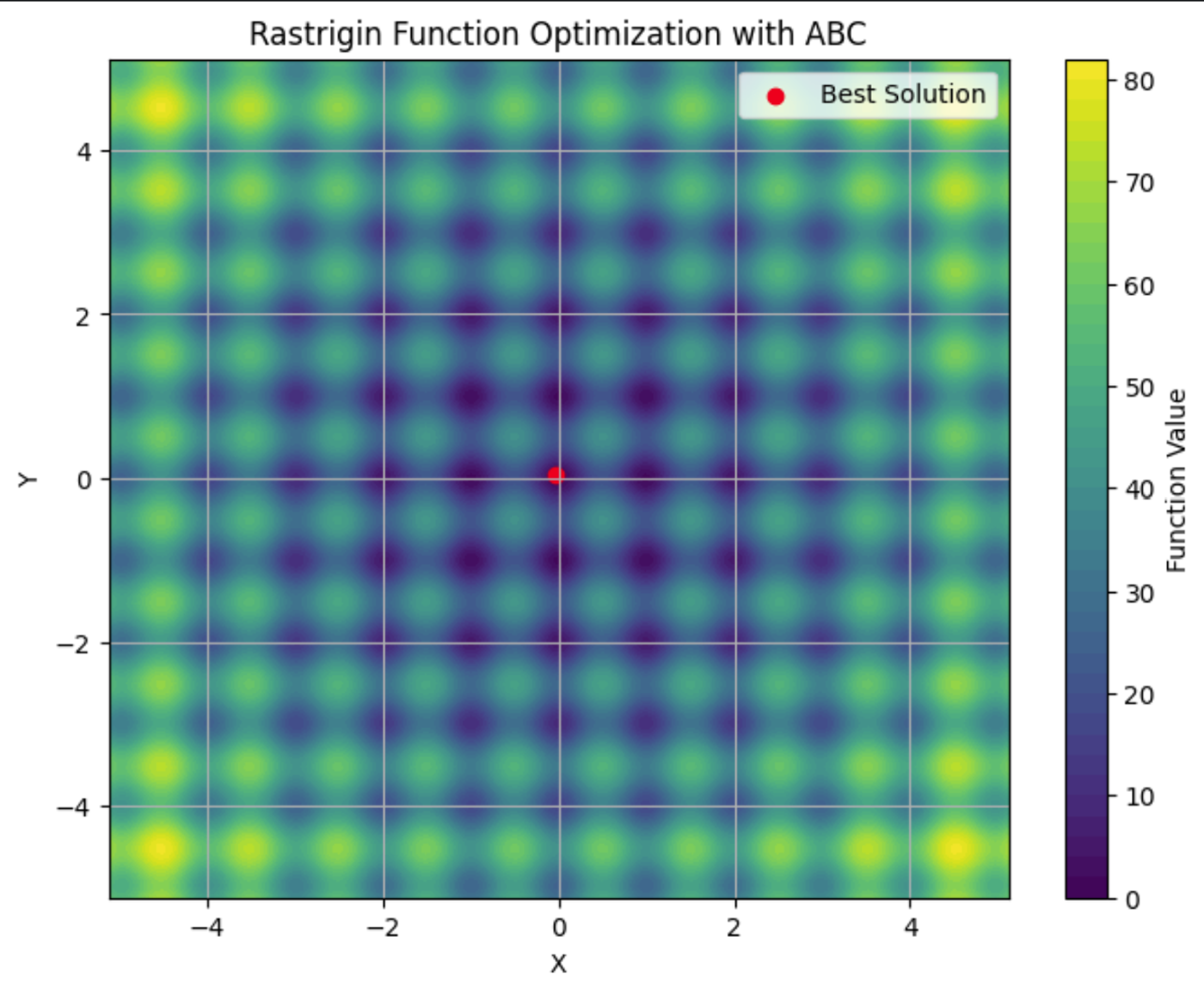群智能算法:三個Python實現
Imagine watching a flock of birds in flight. There's no leader, no one giving directions, yet they swoop and glide together in perfect harmony. It may look like chaos, but there's a hidden order. You can see the same pattern in schools of fish avoiding predators or ants finding the shortest path to food. These creatures rely on simple rules and local communication to tackle surprisingly complex tasks without central control.
That’s the magic of swarm intelligence.
We can replicate this behavior using algorithms that solve tough problems by mimicking swarm intelligence.
Particle Swarm Optimization (PSO)
Particle swarm optimization (PSO) draws its inspiration from the behavior of flocks of birds and schools of fish. In these natural systems, individuals move based on their own previous experiences and their neighbors' positions, gradually adjusting to follow the most successful members of the group. PSO applies this concept to optimization problems, where particles, called agents, move through the search space to find an optimal solution.
Compared to ACO, PSO operates in continuous rather than discrete spaces. In ACO, the focus is on pathfinding and discrete choices, while PSO is better suited for problems involving continuous variables, such as parameter tuning.
In PSO, particles explore a search space. They adjust their positions based on two main factors: their personal best-known position and the best-known position of the entire swarm. This dual feedback mechanism enables them to converge toward the global optimum.
How particle swarm optimization works
The process starts with a swarm of particles initialized randomly across the solution space. Each particle represents a possible solution to the optimization problem. As the particles move, they remember their personal best positions (the best solution they’ve encountered so far) and are attracted toward the global best position (the best solution any particle has found).
This movement is driven by two factors: exploitation and exploration. Exploitation involves refining the search around the current best solution, while exploration encourages particles to search other parts of the solution space to avoid getting stuck in local optima. By balancing these two dynamics, PSO efficiently converges on the best solution.
Particle swarm optimization Python implementation
In financial portfolio management, finding the best way to allocate assets to get the most returns while keeping risks low can be tricky. Let’s use a PSO to find which mix of assets will give us the highest return on investment.
The code below shows how PSO works for optimizing a fictional financial portfolio. It starts with random asset allocations, then tweaks them over several iterations based on what works best, gradually finding the optimal mix of assets for the highest return with the lowest risk.
import numpy as np
import matplotlib.pyplot as plt
# Define the PSO parameters
class Particle:
def __init__(self, n_assets):
# Initialize a particle with random weights and velocities
self.position = np.random.rand(n_assets)
self.position /= np.sum(self.position) # Normalize weights so they sum to 1
self.velocity = np.random.rand(n_assets)
self.best_position = np.copy(self.position)
self.best_score = float('inf') # Start with a very high score
def objective_function(weights, returns, covariance):
"""
Calculate the portfolio's performance.
- weights: Asset weights in the portfolio.
- returns: Expected returns of the assets.
- covariance: Covariance matrix representing risk.
"""
portfolio_return = np.dot(weights, returns) # Calculate the portfolio return
portfolio_risk = np.sqrt(np.dot(weights.T, np.dot(covariance, weights))) # Calculate portfolio risk (standard deviation)
return -portfolio_return / portfolio_risk # We want to maximize return and minimize risk
def update_particles(particles, global_best_position, returns, covariance, w, c1, c2):
"""
Update the position and velocity of each particle.
- particles: List of particle objects.
- global_best_position: Best position found by all particles.
- returns: Expected returns of the assets.
- covariance: Covariance matrix representing risk.
- w: Inertia weight to control particle's previous velocity effect.
- c1: Cognitive coefficient to pull particles towards their own best position.
- c2: Social coefficient to pull particles towards the global best position.
"""
for particle in particles:
# Random coefficients for velocity update
r1, r2 = np.random.rand(len(particle.position)), np.random.rand(len(particle.position))
# Update velocity
particle.velocity = (w * particle.velocity
c1 * r1 * (particle.best_position - particle.position)
c2 * r2 * (global_best_position - particle.position))
# Update position
particle.position = particle.velocity
particle.position = np.clip(particle.position, 0, 1) # Ensure weights are between 0 and 1
particle.position /= np.sum(particle.position) # Normalize weights to sum to 1
# Evaluate the new position
score = objective_function(particle.position, returns, covariance)
if score

This graph demonstrates how much the PSO algorithm improved the portfolio’s asset mix with each iteration.
Applications of particle swarm optimization
PSO is used for its simplicity and effectiveness in solving various optimization problems, particularly in continuous domains. Its flexibility makes it useful for many real-world scenarios where precise solutions are needed.
These applications include:
- Machine learning: PSO can be applied to tune hyperparameters in machine learning algorithms, helping to find the best model configurations.
- Engineering design: PSO is useful for optimizing design parameters for systems like aerospace components or electrical circuits.
- Financial modeling: In finance, PSO can help in portfolio optimization, minimizing risk while maximizing returns.
PSO's ability to efficiently explore solution spaces makes it applicable across fields, from robotics to energy management to logistics.
Artificial Bee Colony (ABC)
The artificial bee colony (ABC) algorithm is modeled on the foraging behavior of honeybees.
In nature, honeybees efficiently search for nectar sources and share this information with other members of the hive. ABC captures this collaborative search process and applies it to optimization problems, especially those involving complex, high-dimensional spaces.
What sets ABC apart from other swarm intelligence algorithms is its ability to balance exploitation, focusing on refining current solutions, and exploration, searching for new and potentially better solutions. This makes ABC particularly useful for large-scale problems where global optimization is key.
How artificial bee colony works
In the ABC algorithm, the swarm of bees is divided into three specialized roles: employed bees, onlookers, and scouts. Each of these roles mimics a different aspect of how bees search for and exploit food sources in nature.
- Employed bees: These bees are responsible for exploring known food sources, representing current solutions in the optimization problem. They assess the quality (fitness) of these sources and share the information with the rest of the hive.
- Onlooker bees: After gathering information from the employed bees, onlookers select which food sources to explore further. They base their choices on the quality of the solutions shared by the employed bees, focusing more on the better options, thus refining the search for an optimal solution.
- Scout bees: When an employed bee’s food source (solution) becomes exhausted or stagnant (when no improvement is found after a certain number of iterations), the bee becomes a scout. Scouts explore new areas of the solution space, searching for potentially unexplored food sources, thus injecting diversity into the search process.
This dynamic allows ABC to balance the search between intensively exploring promising areas and broadly exploring new areas of the search space. This helps the algorithm avoid getting trapped in local optima and increases its chances of finding a global optimum.
Artificial bee colony Python implementation
The Rastrigin function is a popular problem in optimization, known for its numerous local minima, making it a tough challenge for many algorithms. The goal is simple: find the global minimum.
In this example, we’ll use the artificial bee colony algorithm to tackle this problem. Each bee in the ABC algorithm explores the search space, looking for better solutions to minimize the function. The code simulates bees that explore, exploit, and scout for new areas, ensuring a balance between exploration and exploitation.
import numpy as np
import matplotlib.pyplot as plt
# Rastrigin function: The objective is to minimize this function
def rastrigin(X):
A = 10
return A * len(X) sum([(x ** 2 - A * np.cos(2 * np.pi * x)) for x in X])
# Artificial Bee Colony (ABC) algorithm for continuous optimization of Rastrigin function
def artificial_bee_colony_rastrigin(n_iter=100, n_bees=30, dim=2, bound=(-5.12, 5.12)):
"""
Apply Artificial Bee Colony (ABC) algorithm to minimize the Rastrigin function.
Parameters:
n_iter (int): Number of iterations
n_bees (int): Number of bees in the population
dim (int): Number of dimensions (variables)
bound (tuple): Bounds for the search space (min, max)
Returns:
tuple: Best solution found, best fitness value, and list of best fitness values per iteration
"""
# Initialize the bee population with random solutions within the given bounds
bees = np.random.uniform(bound[0], bound[1], (n_bees, dim))
best_bee = bees[0]
best_fitness = rastrigin(best_bee)
best_fitnesses = []
for iteration in range(n_iter):
# Employed bees phase: Explore new solutions based on the current bees
for i in range(n_bees):
# Generate a new candidate solution by perturbing the current bee's position
new_bee = bees[i] np.random.uniform(-1, 1, dim)
new_bee = np.clip(new_bee, bound[0], bound[1]) # Keep within bounds
# Evaluate the fitness of the new solution
new_fitness = rastrigin(new_bee)
if new_fitness

This graph shows the fitness of the best solution found by the ABC algorithm with each iteration. In this run, it reached its optimum fitness around the 64th iteration.

Here you can see the Rastrigin function plotted on a contour plot, with its many local minima. The red dot is the global minima found by the ABC algorithm we ran.
Applications of artificial bee colony
The ABC algorithm is a robust tool for solving optimization problems. Its ability to efficiently explore large and complex search spaces makes it a go-to choice for industries where adaptability and scalability are critical.
These applications include:
- Telecommunications: ABC can be used to optimize the placement of network resources and antennas, maximizing coverage and signal strength while minimizing costs.
- Engineering: ABC can fine-tune parameters in structural design optimization.
- Data Science: ABC can be applied to feature selection, to identify the most important variables in a dataset for machine learning.
ABC is a flexible algorithm suitable for any problem where optimal solutions need to be found in dynamic, high-dimensional environments. Its decentralized nature makes it well-suited for situations where other algorithms may struggle to balance exploration and exploitation efficiently.
Comparing Swarm Intelligence Algorithms
There are multiple swarm intelligence algorithms, each with different attributes. When deciding which to use, it's important to weigh their strengths and weaknesses to decide which best suits your needs.
ACO is effective for combinatorial problems like routing and scheduling but may need significant computational resources. PSO is simpler and excels in continuous optimization, such as hyperparameter tuning, but can struggle with local optima. ABC successfully balances exploration and exploitation, though it requires careful tuning.
Other swarm intelligence algorithms, such as Firefly Algorithm and Cuckoo Search Optimization, also offer unique advantages for specific types of optimization problems.
|
Algorithm |
Strengths |
Weaknesses |
Preferred Libraries |
Best Applications |
|
Ant Colony Optimization (ACO) |
Effective for combinatorial problems and handles complex discrete spaces well |
Computationally intensive and requires fine-tuning |
pyaco |
Routing problems, scheduling, and resource allocation |
|
Particle Swarm Optimization (PSO) |
Good for continuous optimization and simple and easy to implement |
Can converge to local optima and is less effective for discrete problems |
pyswarms |
Hyperparameter tuning, engineering design, financial modeling |
|
Artificial Bee Colony (ABC) |
Adaptable to large, dynamic problems and balanced exploration and exploitation |
Computationally intensive and requires careful parameter tuning |
beecolpy |
Telecommunications, large-scale optimization, and high-dimensional spaces |
|
Firefly Algorithm (FA) |
Excels in multimodal optimization and has strong global search ability |
Sensitive to parameter settings and slower convergence |
fireflyalgorithm |
Image processing, engineering design, and multimodal optimization |
|
Cuckoo Search (CS) |
Efficient for solving optimization problems and has strong exploration capabilities |
May converge prematurely and performance depends on tuning |
cso |
Scheduling, feature selection, and engineering applications |
Challenges and Limitations
Swarm intelligence algorithms, like many machine learning techniques, encounter challenges that can affect their performance. These include:
- Premature convergence: The swarm may settle on a suboptimal solution too quickly.
- Parameter tuning: Achieving optimal results often requires careful adjustment of algorithm settings.
- Computational resources & scalability: These algorithms can be computationally intensive, especially with larger, more complex problems, and their performance might degrade as problem complexity increases.
- Stochastic nature: The inherent randomness in these algorithms can lead to variability in results.
Latest Research and Advancements
A notable trend is the integration of swarm intelligence with other machine learning techniques. Researchers are exploring how swarm algorithms can enhance tasks such as feature selection and hyperparameter optimization. Check out A hybrid particle swarm optimization algorithm for solving engineering problem.
Recent advancements also focus on addressing some of the traditional challenges associated with swarm intelligence, such as premature convergence. New algorithms and techniques are being developed to mitigate the risk of converging on suboptimal solutions. For more information, check out Memory-based approaches for eliminating premature convergence in particle swarm optimization
Scalability is another significant area of research. As problems become increasingly complex and data volumes grow, researchers are working on ways to make swarm intelligence algorithms more scalable and efficient. This includes developing algorithms that can handle large datasets and high-dimensional spaces more effectively, while optimizing computational resources to reduce the time and cost associated with running these algorithms. For more on this, check out Recent Developments in the Theory and Applicability of Swarm Search.
Swarm algorithms are being applied to problems from robotics, to large language models (LLMs), to medical diagnosis. There is ongoing research into whether these algorithms can be useful for helping LLMs strategically forget information to comply with Right to Be Forgotten regulations. And, of course, swarm algorithms have a multitude of applications in data science.
Conclusion
Swarm intelligence offers powerful solutions for optimization problems across various industries. Its principles of decentralization, positive feedback, and adaptation allow it to tackle complex, dynamic tasks that traditional algorithms might struggle with.
Check out this review of the current state of swarm algorithms, “Swarm intelligence: A survey of model classification and applications”.
For a deeper dive into the business applications of AI, check out Artificial Intelligence (AI) Strategy or Artificial Intelligence for Business Leaders. To learn about other algorithms that imitate nature, check out Genetic Algorithm: Complete Guide With Python Implementation.
-
 群智能算法:三個Python實現Imagine watching a flock of birds in flight. There's no leader, no one giving directions, yet they swoop and glide together in perfect harmony. It may...人工智慧 發佈於2025-03-24
群智能算法:三個Python實現Imagine watching a flock of birds in flight. There's no leader, no one giving directions, yet they swoop and glide together in perfect harmony. It may...人工智慧 發佈於2025-03-24 -
 如何通過抹布和微調使LLM更準確Imagine studying a module at university for a semester. At the end, after an intensive learning phase, you take an exam – and you can recall th...人工智慧 發佈於2025-03-24
如何通過抹布和微調使LLM更準確Imagine studying a module at university for a semester. At the end, after an intensive learning phase, you take an exam – and you can recall th...人工智慧 發佈於2025-03-24 -
 什麼是Google Gemini?您需要了解的有關Google Chatgpt競爭對手的一切Google recently released its new Generative AI model, Gemini. It results from a collaborative effort by a range of teams at Google, including members ...人工智慧 發佈於2025-03-23
什麼是Google Gemini?您需要了解的有關Google Chatgpt競爭對手的一切Google recently released its new Generative AI model, Gemini. It results from a collaborative effort by a range of teams at Google, including members ...人工智慧 發佈於2025-03-23 -
 與DSPY提示的指南DSPY(聲明性的自我改善語言程序)通過抽象及時工程的複雜性來徹底改變LLM應用程序的開發。 本教程提供了使用DSPY的聲明方法來構建強大的AI應用程序的綜合指南。 [2 抓取DSPY的聲明方法,用於簡化LLM應用程序開發。 了解DSPY如何自動化提示工程並優化複雜任務的性能。 探索實用的D...人工智慧 發佈於2025-03-22
與DSPY提示的指南DSPY(聲明性的自我改善語言程序)通過抽象及時工程的複雜性來徹底改變LLM應用程序的開發。 本教程提供了使用DSPY的聲明方法來構建強大的AI應用程序的綜合指南。 [2 抓取DSPY的聲明方法,用於簡化LLM應用程序開發。 了解DSPY如何自動化提示工程並優化複雜任務的性能。 探索實用的D...人工智慧 發佈於2025-03-22 -
 自動化博客到Twitter線程本文详细介绍了使用Google的Gemini-2.0 LLM,Chromadb和Shiplit自动化长效内容的转换(例如博客文章)。 手动线程创建耗时;此应用程序简化了该过程。 [2 [2 使用Gemini-2.0,Chromadb和Shatlit自动化博客到twitter线程转换。 获得实用的经...人工智慧 發佈於2025-03-11
自動化博客到Twitter線程本文详细介绍了使用Google的Gemini-2.0 LLM,Chromadb和Shiplit自动化长效内容的转换(例如博客文章)。 手动线程创建耗时;此应用程序简化了该过程。 [2 [2 使用Gemini-2.0,Chromadb和Shatlit自动化博客到twitter线程转换。 获得实用的经...人工智慧 發佈於2025-03-11 -
 人工免疫系統(AIS):python示例的指南本文探討了人造免疫系統(AIS),這是受人類免疫系統識別和中和威脅的非凡能力啟發的計算模型。 我們將深入研究AIS的核心原理,檢查諸如克隆選擇,負面選擇和免疫網絡理論之類的關鍵算法,並用Python代碼示例說明其應用。 [2 抗體:識別並結合特定威脅(抗原)。在AIS中,這些代表了問題的潛在解決方...人工智慧 發佈於2025-03-04
人工免疫系統(AIS):python示例的指南本文探討了人造免疫系統(AIS),這是受人類免疫系統識別和中和威脅的非凡能力啟發的計算模型。 我們將深入研究AIS的核心原理,檢查諸如克隆選擇,負面選擇和免疫網絡理論之類的關鍵算法,並用Python代碼示例說明其應用。 [2 抗體:識別並結合特定威脅(抗原)。在AIS中,這些代表了問題的潛在解決方...人工智慧 發佈於2025-03-04 -
 試著向 ChatGPT 詢問這些關於您自己的有趣問題有没有想过 ChatGPT 了解您的哪些信息?随着时间的推移,它如何处理您提供给它的信息?我在不同的场景中使用过 ChatGPT 堆,在特定的交互后看看它会说什么总是很有趣。✕ 删除广告 所以,为什么不尝试向 ChatGPT 询问其中一些问题来看看它对你的真实看法是什么? 我理想生活中的...人工智慧 發佈於2024-11-22
試著向 ChatGPT 詢問這些關於您自己的有趣問題有没有想过 ChatGPT 了解您的哪些信息?随着时间的推移,它如何处理您提供给它的信息?我在不同的场景中使用过 ChatGPT 堆,在特定的交互后看看它会说什么总是很有趣。✕ 删除广告 所以,为什么不尝试向 ChatGPT 询问其中一些问题来看看它对你的真实看法是什么? 我理想生活中的...人工智慧 發佈於2024-11-22 -
 您仍然可以透過以下方式嘗試神秘的 GPT-2 聊天機器人如果您對人工智慧模型或聊天機器人感興趣,您可能已經看過有關神秘的 GPT-2 聊天機器人及其有效性的討論。 在這裡,我們解釋什麼是 GPT-2 聊天機器人以及如何使用存取它。 什麼是 GPT-2 聊天機器人? 2024年4月下旬,一個名為gpt2-chatbot的神秘AI模型在LLM測試和基準測試...人工智慧 發佈於2024-11-08
您仍然可以透過以下方式嘗試神秘的 GPT-2 聊天機器人如果您對人工智慧模型或聊天機器人感興趣,您可能已經看過有關神秘的 GPT-2 聊天機器人及其有效性的討論。 在這裡,我們解釋什麼是 GPT-2 聊天機器人以及如何使用存取它。 什麼是 GPT-2 聊天機器人? 2024年4月下旬,一個名為gpt2-chatbot的神秘AI模型在LLM測試和基準測試...人工智慧 發佈於2024-11-08 -
 ChatGPT 的 Canvas 模式很棒:有 4 種使用方法ChatGPT 的新 Canvas 模式為世界領先的生成式 AI 工具中的寫作和編輯增添了額外的維度。自從 ChatGPT Canvas 推出以來,我一直在使用它,並找到了幾種不同的方法來使用這個新的 AI 工具。 ✕ 刪除廣告 1 文本編輯 ChatGPT Canvas 是如果你想編輯...人工智慧 發佈於2024-11-08
ChatGPT 的 Canvas 模式很棒:有 4 種使用方法ChatGPT 的新 Canvas 模式為世界領先的生成式 AI 工具中的寫作和編輯增添了額外的維度。自從 ChatGPT Canvas 推出以來,我一直在使用它,並找到了幾種不同的方法來使用這個新的 AI 工具。 ✕ 刪除廣告 1 文本編輯 ChatGPT Canvas 是如果你想編輯...人工智慧 發佈於2024-11-08 -
 ChatGPT 的自訂 GPT 如何暴露您的資料以及如何確保其安全ChatGPT 的自訂 GPT 功能允許任何人為幾乎任何你能想到的東西創建自訂 AI 工具;創意、技術、遊戲、自訂 GPT 都可以做到。更好的是,您可以與任何人分享您的自訂 GPT 創建。 但是,透過分享您的自訂 GPT,您可能會犯下一個代價高昂的錯誤,將您的資料暴露給全球數千人。 什麼是自訂...人工智慧 發佈於2024-11-08
ChatGPT 的自訂 GPT 如何暴露您的資料以及如何確保其安全ChatGPT 的自訂 GPT 功能允許任何人為幾乎任何你能想到的東西創建自訂 AI 工具;創意、技術、遊戲、自訂 GPT 都可以做到。更好的是,您可以與任何人分享您的自訂 GPT 創建。 但是,透過分享您的自訂 GPT,您可能會犯下一個代價高昂的錯誤,將您的資料暴露給全球數千人。 什麼是自訂...人工智慧 發佈於2024-11-08 -
 ChatGPT 可協助您在 LinkedIn 上找到工作的 10 種方式LinkedIn 个人资料的“关于”部分有 2,600 个可用字符,是阐述您的背景、技能、热情和未来目标的绝佳空间。查看您的 LinkedIn 简历,作为您的专业背景、技能和抱负的简明摘要。 向 ChatGPT 提供您所有获胜品质的列表,或将您的简历复制粘贴到其中。要求聊天机器人使用这些信息撰写...人工智慧 發佈於2024-11-08
ChatGPT 可協助您在 LinkedIn 上找到工作的 10 種方式LinkedIn 个人资料的“关于”部分有 2,600 个可用字符,是阐述您的背景、技能、热情和未来目标的绝佳空间。查看您的 LinkedIn 简历,作为您的专业背景、技能和抱负的简明摘要。 向 ChatGPT 提供您所有获胜品质的列表,或将您的简历复制粘贴到其中。要求聊天机器人使用这些信息撰写...人工智慧 發佈於2024-11-08 -
 查看這 6 個鮮為人知的 AI 應用程序,它們可提供獨特的體驗目前,大多数人都听说过 ChatGPT 和 Copilot,这两款引领 AI 热潮的开创性生成式 AI 应用程序。但是您知道吗,大量鲜为人知的 AI 工具可以提供精彩的、独特的经历?这里有六个最好的。 1 Ditto Music Ditto 不是您可以用来创建独特歌曲的众多 AI 音乐生成器之一,而...人工智慧 發佈於2024-11-08
查看這 6 個鮮為人知的 AI 應用程序,它們可提供獨特的體驗目前,大多数人都听说过 ChatGPT 和 Copilot,这两款引领 AI 热潮的开创性生成式 AI 应用程序。但是您知道吗,大量鲜为人知的 AI 工具可以提供精彩的、独特的经历?这里有六个最好的。 1 Ditto Music Ditto 不是您可以用来创建独特歌曲的众多 AI 音乐生成器之一,而...人工智慧 發佈於2024-11-08 -
 這 7 個跡象表明我們已經達到人工智慧的巔峰无论您在网上查找什么,都有网站、服务和应用程序宣称他们使用人工智能使其成为最佳选择。我不了解你的情况,但它的持续存在已经让人厌倦了。 因此,虽然人工智能肯定会留在我们的日常生活中,但有几个迹象表明我们已经达到了人工智能炒作的顶峰。 1 公众兴趣有限 虽然人工智能在科技圈受到了广泛关注,但重要的是要...人工智慧 發佈於2024-11-08
這 7 個跡象表明我們已經達到人工智慧的巔峰无论您在网上查找什么,都有网站、服务和应用程序宣称他们使用人工智能使其成为最佳选择。我不了解你的情况,但它的持续存在已经让人厌倦了。 因此,虽然人工智能肯定会留在我们的日常生活中,但有几个迹象表明我们已经达到了人工智能炒作的顶峰。 1 公众兴趣有限 虽然人工智能在科技圈受到了广泛关注,但重要的是要...人工智慧 發佈於2024-11-08 -
 4 個適合教師、講師和老闆的 AI 檢查 ChatGPT 偵測器工具随着 ChatGPT 能力的进步,区分哪些内容是人类编写的,哪些内容是人工智能生成的变得越来越困难。这使得老师和老板很难识别哪些内容是人手写的,哪些内容是通过 ChatGPT 生成的。 如果您很难区分,这里有最好的 ChatGPT 检测工具 我们如何测试每个 ChatGPT 检查工具 有很多...人工智慧 發佈於2024-11-08
4 個適合教師、講師和老闆的 AI 檢查 ChatGPT 偵測器工具随着 ChatGPT 能力的进步,区分哪些内容是人类编写的,哪些内容是人工智能生成的变得越来越困难。这使得老师和老板很难识别哪些内容是人手写的,哪些内容是通过 ChatGPT 生成的。 如果您很难区分,这里有最好的 ChatGPT 检测工具 我们如何测试每个 ChatGPT 检查工具 有很多...人工智慧 發佈於2024-11-08 -
 ChatGPT 的高級語音功能正在向更多用戶推出如果您曾經想與 ChatGPT 進行全面對話,現在您可以。也就是說,只要你付費就可以獲得使用ChatGPT的特權。更多付費用戶正在存取 ChatGPT 的高級語音模式 (AVM),該模式旨在使與 ChatGPT 的互動感覺更加自然。 高級語音來到 ChatGPT Plus 和 Teams Ope...人工智慧 發佈於2024-11-08
ChatGPT 的高級語音功能正在向更多用戶推出如果您曾經想與 ChatGPT 進行全面對話,現在您可以。也就是說,只要你付費就可以獲得使用ChatGPT的特權。更多付費用戶正在存取 ChatGPT 的高級語音模式 (AVM),該模式旨在使與 ChatGPT 的互動感覺更加自然。 高級語音來到 ChatGPT Plus 和 Teams Ope...人工智慧 發佈於2024-11-08
學習中文
- 1 走路用中文怎麼說? 走路中文發音,走路中文學習
- 2 坐飛機用中文怎麼說? 坐飞机中文發音,坐飞机中文學習
- 3 坐火車用中文怎麼說? 坐火车中文發音,坐火车中文學習
- 4 坐車用中文怎麼說? 坐车中文發音,坐车中文學習
- 5 開車用中文怎麼說? 开车中文發音,开车中文學習
- 6 游泳用中文怎麼說? 游泳中文發音,游泳中文學習
- 7 騎自行車用中文怎麼說? 骑自行车中文發音,骑自行车中文學習
- 8 你好用中文怎麼說? 你好中文發音,你好中文學習
- 9 謝謝用中文怎麼說? 谢谢中文發音,谢谢中文學習
- 10 How to say goodbye in Chinese? 再见Chinese pronunciation, 再见Chinese learning

























